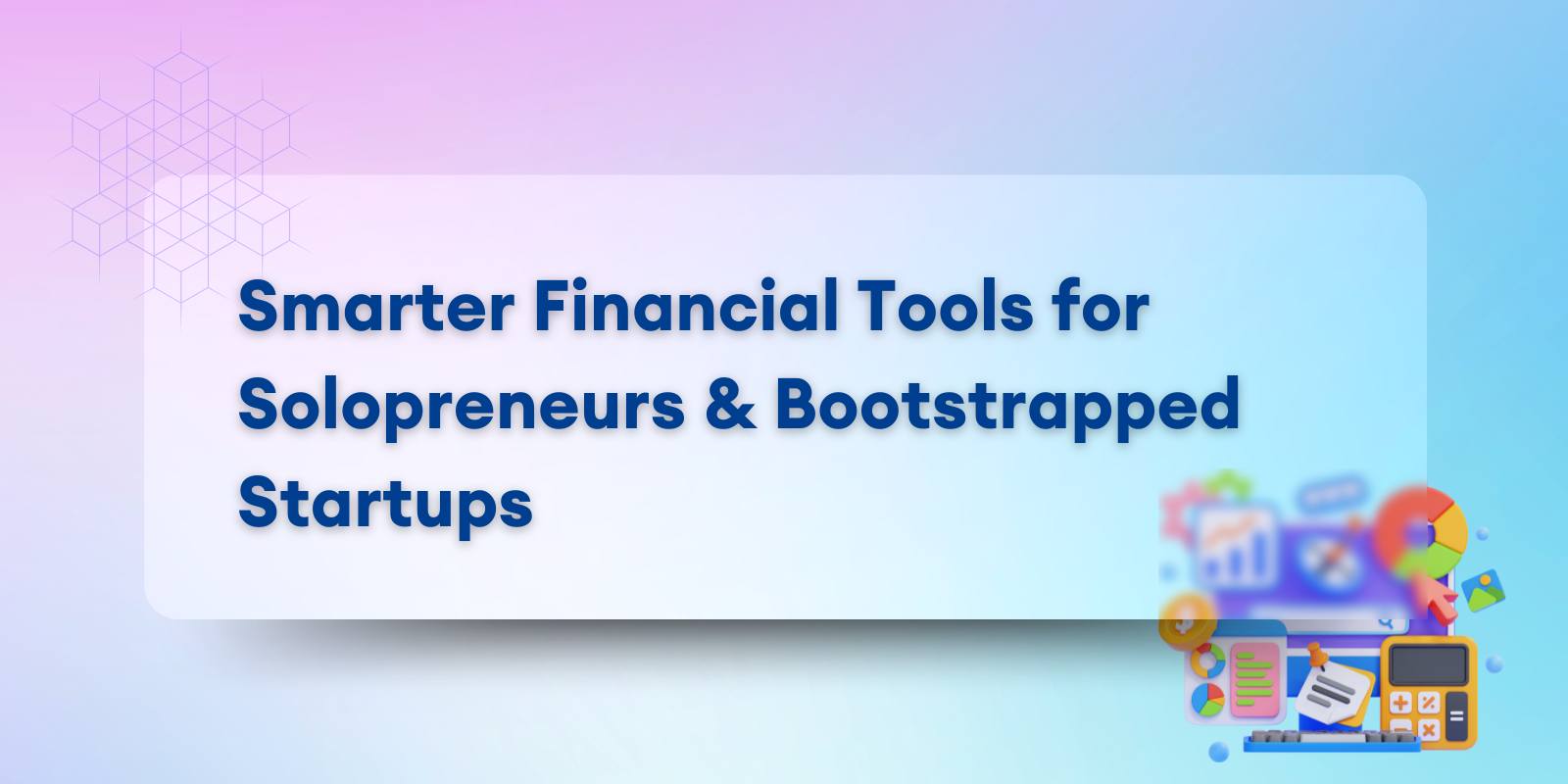
You started with a spreadsheet. We all did.
It’s familiar, flexible, and free, and in the early days of running a solo business, that’s exactly what you need. A few tabs, some formulas, and voilà: you’re tracking income, watching expenses, and feeling like a real operator.
But then things shift.
A new revenue stream pops up. You add a product. A few clients. Maybe you hire a contractor or prep for a launch. Suddenly that trusty sheet has ballooned into a dozen versions, and you’re not even sure if the numbers make sense anymore.
This post is for solopreneurs who are wondering if they’ve outgrown their DIY setup, and what smarter, not scarier, systems might help. We’ll break down the signs it’s time to upgrade, share a roadmap for leveling up (without the overwhelm), and show you how to think like a business, even if you’re still a team of one.
Why Spreadsheets Work, Until They Don’t
The Comfort of Sheets
Every solopreneur starts with a spreadsheet. And honestly? It’s not a bad move.
Spreadsheets are easy to set up, flexible enough to do just about anything, and they don’t cost a dime. You can slap together a revenue tracker, invoice log, or monthly budget in an afternoon. You’re in control. You know where everything lives. You don’t need to learn a new tool just to stay organized.
For solo founders just starting out, or operating with razor-thin margins, spreadsheets feel like a gift. They let you move fast, stay lean, and figure things out as you go.
The Cracks That Eventually Show
But as your business grows, so does the complexity. One-off invoices turn into monthly retainers. Digital products start bringing in daily payments. You expand to new income streams, maybe affiliates, coaching, or ad revenue. Then you try to make sense of it all in the same spreadsheet you hacked together last year.
Suddenly you’re dealing with:
- Endless tabs and conflicting versions
- Manual updates you constantly forget to do
- Zero visibility into trends or forecasts
- A vague sense that you might be making money, but no way to prove it
What started as a flexible solution turns into a fragile one. And every time tax season rolls around or you prep for a launch, that fragile system starts to creak under pressure.
You don’t need to ditch your spreadsheet today, but knowing when it’s holding you back? That’s where the shift begins.
Signs You’re Outgrowing the Spreadsheet Era
Spreadsheets are like duct tape for solopreneurs, surprisingly effective, but never built for scale. If you’re feeling friction in your finances, these are the most common warning signs that it’s time to upgrade.
You’re Managing More Than One Revenue Stream
One product? Easy. But once you’re juggling client work, coaching calls, digital products, and affiliate income, the “monthly total” cell in your spreadsheet starts lying. You end up guessing which income sources are working best, or worse, lumping them all together.
Let’s say you make $6K this month. Where did it come from? What’s predictable? What’s a fluke? If your spreadsheet can’t answer that, you’re running blind. You need visibility, not vibes.
You Can’t Tell If You’re Profitable (or Just Busy)
Money is flowing in. But is any of it actually yours?
Many solopreneurs forget to subtract tools, taxes, contractor costs, and ad spend. The result? A busy month that feels successful, but ends up netting $0 or worse. You can’t grow a business without knowing what you’re keeping.
You’re Planning Launches or Hiring Help, but Blindfolded
You want to invest in growth. Maybe hire a VA. Maybe run a promo. But without forecasting tools, you’re stuck guessing, and gut-based budgeting only works for so long.
Here’s where a small shift makes a big difference.
Even a lightweight financial planning tool can help you map income, predict expenses, and answer crucial “what-if” questions, without turning your brain to mush.
You’re Stressed Every Time You Open Your Sheet
If your spreadsheet causes more dread than clarity, it’s not a system, it’s a signal. Outgrowing your setup isn't a failure. It’s proof that you’re evolving.
The Solopreneur’s Financial Upgrade Path. One Step at a Time
You don’t need to go from spreadsheet chaos to enterprise dashboards overnight. In fact, trying to jump five steps ahead is what leads to overwhelm. The most sustainable upgrades are the ones that feel like natural extensions of what you’re already doing, tools that work with you, not against you.
Here’s a realistic, low-stress ladder for leveling up your financial systems, each stage designed to match your current level of complexity, capacity, and ambition.
Stage 1: Stay Scrappy (Google Sheets + Tally)
For side hustlers or early-stage solo founders, this combo still works great. You can:
- Manually track income and expenses
- Send simple invoices with Tally or even PayPal
- Log receipts and categorize transactions by hand
This is the “prove the concept” phase. Keep it simple. Stay lean.
Stage 2: Add Structure (Notion + Zapier)
You’re gaining traction. You’re repeating tasks. You’re losing track of things.
Now it’s time to set up reusable systems:
- Build a financial dashboard in Notion with monthly tracking templates
- Automate invoice tracking with Zapier zaps between Stripe, Gmail, and Notion
- Add reminders for tax estimates, payouts, and monthly summaries
This setup buys back time and helps you think more like a business.
Stage 3: Get Smart (Airtable + Make)
You’re now running multiple income streams or building toward recurring revenue (like memberships or subscription products). Complexity creeps in.
This is where no-code automation shines:
- Track transactions in real time with Airtable forms and filters
- Build dashboards that update automatically
- Use Make to sync Stripe data, tag transaction types, or send alerts for anomalies
Now you’re not just tracking. You’re managing, with data that tells a story.
Stage 4: Start Forecasting
You’re no longer wondering if your idea works. You’re planning the next 6-12 months with intention. Maybe you’re budgeting for a VA. Maybe you’re prepping a launch. Either way, you need reliable, high-level visibility.
This is where a more robust platform like Pigment enters the picture:
Built for teams, but usable by ambitious solo founders, Pigment gives you CFO-level modeling power, without needing to be a CFO. You can forecast revenue, simulate cost increases, or see how different scenarios affect your cash flow, all in one place.
It’s not about going “pro” overnight, it’s about preparing for the moment your business starts demanding it.
What a “Real” Financial Setup Looks Like (Even for One-Person Businesses)
You don’t need a finance degree, or a finance department, to run a solid business. What you need is a system that works for you: one that offers clarity, reduces stress, and makes decision-making easier.
Here’s what a “grown-up” financial setup can look like for a solo founder, without feeling bloated, overbuilt, or impossible to manage.
1. Clear Revenue + Expense Visibility
You should be able to answer, at a glance:
- How much you made last month (by product, service, or client)
- How much you spent, and on what
- Your average monthly profit over the past 90 days
No detective work. No chasing down PayPal receipts. Just clean, categorized data that lives in one place.
2. Forecasting and Scenario Planning
What happens if you raise your rates? Add a new product? Hire a contractor?
A mature setup lets you model those “what if” situations before you make the move. This doesn’t need to be complex. In Airtable or Notion, it could be as simple as a duplicate of your income tracker with new assumptions.
But when you need deeper visibility, like how changes impact your cash flow over 6-12 months, that’s when tools like Pigment start to shine.
3. Launch & Campaign Planning
Your next launch shouldn’t be a shot in the dark.
Track costs, projected income, and time investment. Compare campaigns. Monitor performance in real-time. See what’s profitable vs. what just felt good.
A real system helps you learn from every push, not just hope the next one “hits better.”
4. Tax Time Made Easy
A good system doesn’t just help you grow, it saves your sanity when things like taxes roll around.
You should be able to export categorized transactions for your accountant in minutes, not spend days digging through Stripe exports.
5. A Cash Buffer System
Real businesses protect themselves. Even solo ones.
This means building a small reserve you can fall back on when revenue slows or something unexpected hits. Know your baseline expenses. Set a minimum reserve. Make decisions from a place of confidence, not panic.
You don’t need a war chest, but even 2-3 months of operating buffer can be a game-changer.
Every piece you put in place isn’t just about tidiness, it’s about freedom. You’ll spend less time reacting, and more time building with clarity and confidence.
You Don’t Need a Team to Think Like a Business
There’s a myth that real financial systems are for “later”, once you have a team, an accountant, or a CFO. But that mindset keeps too many solo founders stuck.
The truth? Some of the most efficient, organized businesses are run by one person, using simple tools and strong systems.
Being a solopreneur doesn’t mean winging it. It means being intentional, with your time, your energy, and yes, your money.
Structure Creates Freedom
You didn’t go solo to build a bloated back office. But that doesn’t mean flying blind is a better alternative.
Smart systems protect your time and headspace. When you stop manually copying data between tabs or redoing the same invoice template every month, you free up bandwidth to think, create, and grow.
The more you automate and organize, the less you stress, and the more you ship.
Professional Doesn’t Mean Complicated
Real businesses don’t rely on messy sheets, scattered receipts, or last-minute guesses. And neither should yours.
The tools are here, many of them free or low-cost. You just need to know what to plug in, and when.
It’s not about adding complexity. It’s about replacing friction with flow.
You’re Already the CEO
You’re not going to be a founder. You already are.
You’re making product decisions. Budgeting. Marketing. Serving customers. Wearing all the hats. That is the job.
So why not make your life easier?
Build like a business now, and your future self (and future team) will thank you for it.
In Conclusion
You don’t need to overhaul everything overnight. But you do need systems that grow with you.
If you’ve been feeling overwhelmed by scattered data, inconsistent income, or foggy decision-making, take that as a signal. You’re not behind. You’re just ready for better tools.
Start small. Build steady. And give yourself the kind of financial clarity that makes every creative risk feel just a little safer.
Need help figuring out where you stand? Start by listing your income streams and expenses. If it takes longer than 5 minutes, your spreadsheet days might be numbered, and that’s a good thing.




